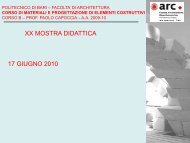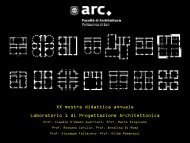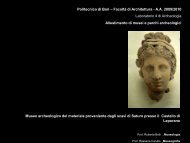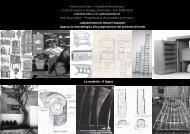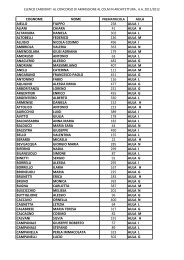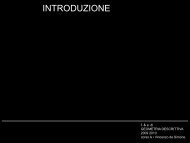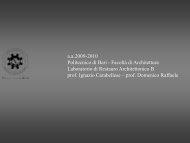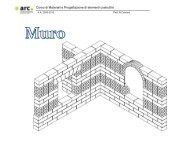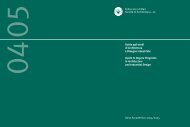44. I regolamenti <strong>di</strong>dattici94century - The urban art in the age of theTetrarchism - The sculpture in colouredmarbles: typologies, places of production andcommerce – General characters of thefigurative arts in Costantinian age– Thedevelopment of Roman paintings and mosaicbetween II and IV century a.D.2nd semester: Archaeology and History ofRoman art: the Roman provinces.Geographical position and territorialgroupings of the Roman provinces – historyand formation of the Roman provinces -topography and urbanistic of the romanprovinces - local cultural, artistic tra<strong>di</strong>tionsand phaenomena of Roman culture <strong>di</strong>ffusion -the problem of the provincial art - the moremeaningful archaeological documentation ofthe single provinces – deep examination ofthe artistic experiences of a Roman province:the Achaia.Exercises: rea<strong>di</strong>ng and interpretation ofimages regar<strong>di</strong>ng archaeological contexts anddocuments of Roman age, bibliographicalsearches.Instructing journeys.Articolazione delle attività <strong>di</strong>datticheL’attività <strong>di</strong>dattica si articolerà in lezioni,destinate ad affrontare la materia in formarigorosamente <strong>di</strong>acronica, esercitazionibibliografiche, volte ad acquisire glistrumenti e la metodologia necessari acondurre ricerche bibliografiche, e d<strong>il</strong>ettura <strong>di</strong> un contesto archeologicofinalizzate ad una più compiutacomprensione del linguaggio formale edell’articolazione dell’arte romana, viaggi<strong>di</strong> istruzione, destinati ad integrare conl’esperienza <strong>di</strong>retta le cognizioni teoricheacquisite nell’ambito del corso.Articulation of educational activityLessons in <strong>di</strong>achronic form, interpretingexercises of an archaeological context for amore complex understan<strong>di</strong>ng of the formallanguage and articulation of the Roman art,bibliographical exercises to acquire thetools and necessary methodology toconduct bibliographical searches,educational journeys, destined to integratewith <strong>di</strong>rected experience the theoreticalknowledges acquired within the course..Iscrizione al corsoLe iscrizioni avvengono obbligatoriamentesulla piattaforma e-learning entro i primi<strong>di</strong>eci giorni dall’inizio dei corsi.Modalità d’esamePer sostenere l’esame è necessaria lafrequenza del corso che consentel’acquisizione dei cre<strong>di</strong>ti previsti: talefrequenza sarà r<strong>il</strong>evata nei mo<strong>di</strong> e nelleforme che <strong>il</strong> docente riterrà più opportuni.In sede <strong>di</strong> esame sarà valutata laconoscenza e la capacità <strong>di</strong> valutazionestorico-critica della materia, attraverso uncolloquio integrato da lettura einterpretazione <strong>di</strong> immagini <strong>di</strong> materiali econtesti archeologici.4.2.10 Progetti <strong>di</strong>dattici del II ciclo delCdLs in ArchitetturaLaboratorio 3 <strong>di</strong> ProgettazioneArchitettonicaArchitectural Design Stu<strong>di</strong>o, 3rd yearL3PA-10 cfu3° anno / corso annualeArea <strong>di</strong>dattica I:Progettazione architettonica e urbana• Progettazione architettonica (Icar 14-7 cfu)•• Tecnica delle costruzioni A (Icar 14-3 cfu)Corso A• Ariella Zattera•• Vincenzo GiannuzziCorso B• Carlo Moccia•• Calogero DentamaroCorso C• Anna Bruna Menghini•• Domenico RaffaeleCorso D• Matteo Ieva•• Domenico RaffaeleCorso E• Calogero Montalbano•• Calogero DentamaroCorso F• Michele Montemurro•• Vincenzo GiannuzziFinalità e contenuti <strong>di</strong>sciplinariObiettivo del corso è portare gli allievi adun più alto e complesso grado <strong>di</strong>comprensione delle problematiche proprie<strong>di</strong> un organismo architettonico complesso(specialistico).Lo studente dovrà acquisire, me<strong>di</strong>antel’appren<strong>di</strong>mento teorico e le applicazioniprogettuali, la capacità <strong>di</strong> lettura econtrollo del processo <strong>di</strong> definizione dellastruttura formale assumendo comeatteggiamento fondativo la concezioneunitaria della forma architettonicostrutturale.A tal fine dovrà produrremodelli <strong>di</strong> stu<strong>di</strong>o che rendano evidente <strong>il</strong>principio morfologico-strutturale e insiemelogico–formale da assumere a fondamentodell’esercizio del progetto. Lo studentedovrà eseguire lo sv<strong>il</strong>uppo del progetto alle<strong>di</strong>verse scale <strong>di</strong> approfon<strong>di</strong>mento,controllandone le implicazioni legate allaconcezione strutturale e alla coerentelogica impiantistica.Aims and contentsThe aim is to bring the students to anhigher and more complex understan<strong>di</strong>ngdegree of the intrinsic problems of acomplex architectural organism (specialist).The student w<strong>il</strong>l have to acquire, throughtheoretical and practical learning, theab<strong>il</strong>ity to read and control the definitionprocess of the form structure by assumingthe unitary conception of the architectural/structural form as a starting point.For this end he w<strong>il</strong>l realize study-modelsthat could show the principle bothmorphologic-structural and formal-logic toassume as designing exercise base.
The student w<strong>il</strong>l develope the architecturalproject at the <strong>di</strong>fferent scales of search,verifying its implications in order to itsstructural conception and to coherent logicof equipments.Tema d’annoIl tema d’anno è costituito dal progetto <strong>di</strong>un organismo architettonico caratterizzatodalla compresenza <strong>di</strong> spazi, scalarmente<strong>di</strong>fferenziati, <strong>di</strong> cui <strong>il</strong> “centrale”, dominanteed unitario.Nei corsi A B C E F <strong>il</strong> tema <strong>di</strong> progetto èquello <strong>di</strong> una piccola bibliotecauniversitaria, nel corso D quello <strong>di</strong> unachiesa. La riflessione progettuale siconcentrerà soprattutto sul ruolo dellastruttura nella definizione spaziale e sulsignificato e i caratteri del luogo dellalettura (nel caso della biblioteca) e dellaliturgia (nel caso della chiesa). Nell’ambitodell’insegnamento <strong>di</strong> Tecnica delleCostruzioni, gli studenti dovrannorealizzare elaborati che <strong>il</strong>lustrino <strong>il</strong> modellostrutturale complessivo del progetto ed<strong>il</strong> suo funzionamento statico.Design problemThe year design problem is a multi spacearchitectural organism, <strong>di</strong>fferentiated byscale and hierarchy, whose “central” spaceis unitary and dominant.In the A B C E F courses, the designproblem is a small library in a campus; inthe D course a small church. Main attentionw<strong>il</strong>l tribute to structure’s role incharacterizing the space, the meaning andfeatures of the library and of the church.In the module “Construction techniques”the students w<strong>il</strong>l realize both the structuraland the static model.Articolazione delle attività <strong>di</strong>datticheProgettazione architettonicaIl corso prevede lo svolgimento <strong>di</strong> lezioni el’esercizio costante <strong>di</strong> una attività <strong>di</strong>progettazione in aula sotto la guida delladocenza.Le lezioni sono riferite alle questioni dellateoria che assumono, al terzo anno, unruolo centrale nella formazione. Sarannoaffrontati i temi dell’organismoarchitettonico (attraverso la trattazione deiconcetti <strong>di</strong> “struttura formale”, <strong>di</strong> “unitàformale-costruttiva”, <strong>di</strong> “serialitàorganicità”),dell’espressività dellacostruzione (attraverso l’esame dei“caratteri architettonici” della costruzionemuraria e della costruzione a scheletro),della relazione evocativa che <strong>il</strong> linguaggiostab<strong>il</strong>isce con la forma storica.L’appren<strong>di</strong>mento del “saper fare” saràorganizzato secondo tre fasi: la prima fase(ottobre-<strong>di</strong>cembre) sarà de<strong>di</strong>cata allalettura critica <strong>di</strong> organismi architettonicostrutturalie alla definizione dei modellimorfologico-strutturali e logico-formali. Glistudenti approfon<strong>di</strong>ranno, nella successivafase (gennaio-marzo), la definizione deiprincipi <strong>di</strong> aggregazione tra le partidell’organismo architettonico e ladefinizione dei principi statico-costruttiviche caratterizzeranno l’”invenzione” dellamorfologia strutturale. La terza fase(marzo–giugno) sarà de<strong>di</strong>cataall’affinamento delle scelte adottate. Inquesto fase <strong>il</strong> problema formale dellinguaggio sarà costantemente ricondottoal ruolo degli elementi nella costruzione.Per questo grande attenzione si de<strong>di</strong>cheràal “dettaglio” costruttivo.Architectural design stu<strong>di</strong>oThe course consists of theoretical lecturesand constant exercise of designing activityin classroom under the teacher’ssupervision.Lectures w<strong>il</strong>l refer to theoretical questionswhich have, at the third year of the school,a central role for training. They w<strong>il</strong>l dealwith architectural organism subjects (bytreating arguments as: “the structure ofform”, “form-construction unity”, “serialorganiccharacteristic”), with constructionexpressiveness (by consideringarchitectural characteristics of masonryand skeleton bu<strong>il</strong><strong>di</strong>ng), with evocativerelation between language and historicalforms.The learning of “know how” w<strong>il</strong>l beorganized into three phases: first phase(October-December) w<strong>il</strong>l be de<strong>di</strong>cated tothe critic rea<strong>di</strong>ng of structural-architecturalorganisms and to the settlement ofmorphological-structural and logical-formalmodels. In the second phase (January-March) the students w<strong>il</strong>l deepen theprinciples of the union among the parts ofthe architectural organism and the staticbu<strong>il</strong><strong>di</strong>ngprinciples that characterize the“invention” of the structural morphology.Third phase (March-June) w<strong>il</strong>l be de<strong>di</strong>catedto the refinement of the chosen solutions.Into this phase, the formal problem of thelanguage w<strong>il</strong>l be constantly referred to therole of bu<strong>il</strong><strong>di</strong>ng elements. So, a big care w<strong>il</strong>lbe token to “deta<strong>il</strong>”.Tecnica delle costruzioniIl corso si prefigge la finalità <strong>di</strong> prepararel’allievo a cogliere gli aspetti strutturali <strong>di</strong>un organismo architettonico attraverso ladefinizione <strong>di</strong> “modelli” dell’assettoformale e costruttivo, calibrati in funzionedei materiali ut<strong>il</strong>izzati e del comportamentostatico globale.In particolare l’allievo sarà seguito nelpassaggio fondamentale fra la fase <strong>di</strong>intuizione della forma strutturale a quellache analizza l’interazione e l’integrazionedella modellazione costruttiva con lavisione più ampia della concezionearchitettonica.A tal fine le lezioni saranno impostatesull’analisi dei principi generali <strong>di</strong>funzionamento statico <strong>di</strong> organismistrutturali a composizione muraria ovvero atelaio. Saranno evidenziate le peculiaritàdei modelli strutturali la cui risposta statica<strong>di</strong>pende essenzialmente dalla loroconfigurazione formale e <strong>di</strong> quelli <strong>il</strong> cuicomportamento è principalmente regolatodalla <strong>di</strong>stribuzione delle masse resistenti.Technique of constructionsThe aim of the course is prepare thestudent to understan<strong>di</strong>ng the structuralfeatures of the architectural organism,through the definition of formal andconstructive bonds “models”, calibrated inconnection with the materials used andstatic behaviour.In particular, the student w<strong>il</strong>l be driventrough the essential passage from thestructural form intuition phase towards theintegration phase between bu<strong>il</strong><strong>di</strong>ngmodelling and architectural concept as a44.2.10 Progetti <strong>di</strong>dattici del II ciclo del CdLm in Architettura95
- Page 1:
0607Politecnico di BariFacoltà di
- Page 4 and 5:
Politecnico di Bari, Facoltà di Ar
- Page 6 and 7:
4. Regolamenti didattici4.1. Il Reg
- Page 8 and 9:
PresentazionePresentazioneLa Facolt
- Page 11 and 12:
Le strutture didattiche e di suppor
- Page 13 and 14:
giorno e dando, quindi, esecutivit
- Page 15 and 16:
• esprimere pareri sui compiti di
- Page 17 and 18:
1.3. La Biblioteca di FacoltàIl pa
- Page 19 and 20:
2. Strutture di ricerca e di suppor
- Page 21 and 22:
BIO 07, Ecologia43 Mariavaleria Min
- Page 23 and 24:
le richieste e le iniziative ad ess
- Page 25:
2.3 Le biblioteche d’area2.3.1 Le
- Page 28 and 29:
33. La didattica e gli studenti263.
- Page 31 and 32:
4. I Regolamenti didattici4.1. Rego
- Page 33 and 34:
presente regolamento;• le propede
- Page 35 and 36:
discussi ed i voti finali.Per ciasc
- Page 37 and 38:
4.2.4 Definizione delle aree discip
- Page 39 and 40:
laurea da attivare in base al numer
- Page 41 and 42:
non venga superato l’iscrizione a
- Page 43 and 44:
Manifesto del CdLs in Architettura
- Page 45 and 46: Manifesto del CdLm in Architettura
- Page 47 and 48: ciclo provenendo da altri Atenei.È
- Page 49 and 50: Manifesto del CdLs in Architettura
- Page 51 and 52: Manifesto del CdLm in Architettura
- Page 53 and 54: Insegnamenti ssd Crediti Laboratori
- Page 55 and 56: Insegnamenti ssd Crediti Laboratori
- Page 57 and 58: Insegnamenti attivati e docenti per
- Page 59 and 60: Insegnamenti attivati e docenti per
- Page 61 and 62: Finalità e contenuti disciplinariN
- Page 63 and 64: Lezioni- L’architettura etrusca e
- Page 65 and 66: ibliografiche, volte ad acquisire g
- Page 67 and 68: Discipline tecnologiche per l’Arc
- Page 69 and 70: Istituzioni di geometria I + Istitu
- Page 71 and 72: architettonicoTopicsLife drawing, u
- Page 73 and 74: • Representation of the shadows
- Page 75 and 76: frequenza del corso che consentel
- Page 77 and 78: capacità di valutazione storico-cr
- Page 79 and 80: scale edilizie e tra diversi tipi;
- Page 81 and 82: planning of Roman suburban andcount
- Page 83 and 84: mutation through the works of the p
- Page 85 and 86: -Equazioni indefinite di equilibrio
- Page 87 and 88: coerenza tra qualità funzionale, c
- Page 89 and 90: transformations (psychrometry).In t
- Page 91 and 92: madrepatria.4. La colonizzazione e
- Page 93 and 94: EtruscologiaEtruscologyL-ANT/07 - 4
- Page 95: Archeologia e Storia dell’Arte Ro
- Page 99 and 100: tanto il rapporto tra elementi, str
- Page 101 and 102: sociale dell’abitare (Loos, Tesse
- Page 103 and 104: experimental research into the beha
- Page 105 and 106: Articolazione dell’attività dida
- Page 107 and 108: Aims and contentsThe Urban Sociolog
- Page 109 and 110: nell’ambito dell’annuale “mos
- Page 111 and 112: di laurea. Sarà quindi necessario
- Page 113 and 114: - Ancient modern Rome: the continui
- Page 115 and 116: During the lessons, theoretical and
- Page 117 and 118: Le esercitazioni costituiscono lo s
- Page 119 and 120: typological and technical innovatio
- Page 121 and 122: • la fenomeni di propagazione del
- Page 123 and 124: Aims and contentsThe urban economy,
- Page 125 and 126: value of a civil apartment with the
- Page 127 and 128: l’elaborazione della tesi di rice
- Page 129 and 130: 4.3.8 Esame di laureaPer essere amm
- Page 131 and 132: semestrale• Laboratori di sintesi
- Page 133 and 134: 4.3.14 Manifesto del CdL in Disegno
- Page 135 and 136: 4.3.16 Organizzazione delle attivit
- Page 137 and 138: 4.3.17 Insegnamenti e docenti per a
- Page 139 and 140: Laboratorio di Disegno industriale
- Page 141 and 142: • metodo dell’assonometria;•
- Page 143 and 144: fine dell’Ottocento; le avanguard
- Page 145 and 146: Iscrizione al corsoLe iscrizioni av
- Page 147 and 148:
Laboratorio di Arredamento 2/IInter
- Page 149 and 150:
Disegno 2/IIDrawing 2/IIIcar 17-5 c
- Page 151 and 152:
communication, as follows:• typog
- Page 153 and 154:
4.3.22 Progetti didattici3° anno
- Page 155 and 156:
sintetiche, segnaletica interna ed
- Page 157:
esercitazioni pratiche, attività d
- Page 160 and 161:
55. Relazioni internazionali1585.1
- Page 163 and 164:
6. Post Lauream6.1. Dottorato di Ri
- Page 165 and 166:
Attività di ricercaLo svolgimento
- Page 167 and 168:
particolari e specifiche competenze
- Page 169 and 170:
iscrizione all’esame di ammission
- Page 171 and 172:
scientifico-disciplinare in cui è
- Page 173:
• alla sicurezza statica (corrett
- Page 176 and 177:
a.1 Planimetria del campus epiante
- Page 178 and 179:
Status accademico dei docentiDocent
- Page 180 and 181:
aAppendici178A.3 Indice dei nomiAAc
- Page 182 and 183:
aAppendicia.5 Calendario annuale de




